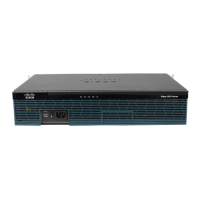271
Cisco 3900 Series, Cisco 2900 Series, and Cisco 1900 Series Integrated Services Routers Generation 2 Software Configuration Guide
Chapter Configuring Radio Settings
Configuring Radio Transmit Power
Configuring Radio Transmit Power
Radio transmit power is based on the type of radio or radios installed in your access point and the
regulatory domain in which it operates.
To set the transmit power on access point radios, follow these steps, beginning in privileged EXEC mode.
SUMMARY STEPS
1. configure terminal
2. interface dot11radio {0| 1}
3. power local level
4. end
5. copy running-config startup-config
DETAILED STEPS
Use the no form of the power local command to return the power setting to maximum, the default
setting.
Limiting the Power Level for Associated Client Devices
You can also limit the power level on client devices that associate to the wireless device. When a client
device associates to the wireless device, the wireless device sends the maximum power level setting to
the client.
Note Cisco AVVID documentation uses the term Dynamic Power Control (DPC) to refer to limiting the power
level on associated client devices.
To specify a maximum allowed power setting on all client devices that associate to the wireless device,
follow these steps, beginning in privileged EXEC mode.
Command Purpose
Step 1
configure terminal Enters global configuration mode.
Step 2
interface dot11radio {0| 1} Enters interface configuration mode for the radio interface.
The 2.4-GHz and the 802.11g/n 2.4-GHz radios are radio 0.
The 5-GHz and the 802.11n 5-GHz radio is radio 1.
Step 3
power local
These options are available for the
2.4-GHz 802.11n radio (in dBm):
{8 | 9| 11 | 14 | 15 | 17 | maximum}
Sets the transmit power for the radio, or the 5-GHz radio so that
the power level is allowed in your regulatory domain.
Step 4
end Returns to privileged EXEC mode.
Step 5
copy running-config startup-config (Optional) Saves your entries in the configuration file.

